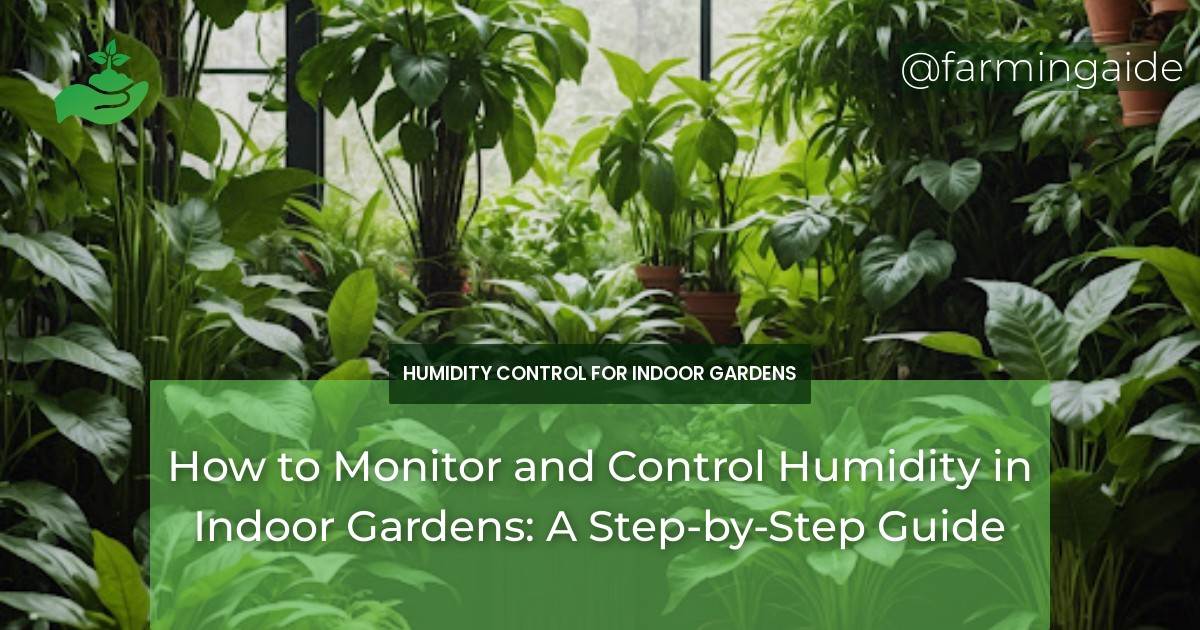Creating an ideal environment for your indoor garden to thrive can be a delicate balancing act. One crucial aspect often overlooked by indoor gardeners is humidity. Maintaining optimal humidity levels is essential for plant health, growth, and development. In this comprehensive guide, we’ll delve into the world of humidity, exploring its significance, monitoring tools, control methods, and daily and seasonal management techniques to ensure your indoor garden flourishes.
Key Takeaways
- Understanding the importance of humidity in indoor gardens
- Identifying ideal humidity levels for different plants
- Selecting the right tools for monitoring humidity
- Implementing techniques for controlling humidity
- Managing humidity on a daily and seasonal basis
Understanding Humidity in Indoor Gardens
Humidity is the amount of moisture present in the air. In indoor gardens, humidity plays a vital role in plant health, as it directly affects photosynthesis, transpiration, and overall growth. Plants thrive in environments with optimal humidity levels, which vary depending on the species. Generally, most indoor plants prefer a relative humidity (RH) between 40% and 60%.
When humidity levels are too low, plants may experience stress, leading to issues like dryness, leaf curl, and increased susceptibility to pests and diseases. On the other hand, excessively high humidity can cause root rot, fungal diseases, and decreased oxygen availability.
Importance of Humidity for Plant Health
Humidity’s significance extends beyond mere aesthetics, as it affects various aspects of plant health:
- Water uptake and transport: Humidity influences the rate of water absorption through the roots.
- Photosynthesis: Optimal humidity enables efficient CO2 absorption and oxygen production.
- Disease resistance: Balanced humidity helps plants defend against fungal and bacterial infections.
Ideal Humidity Levels for Different Plants
Different plant species have unique humidity requirements. Here’s a general guide to ideal humidity ranges for popular indoor plants:
| Plant Type | Ideal Humidity Range |
|---|---|
| Ferns and Peace Lilies | 50-70% |
| Succulents and Cacti | 40-50% |
| Tropical Plants (e.g., Orchids, Bromeliads) | 60-80% |
| Herbs and Leafy Greens | 40-60% |
Tools for Monitoring Humidity
Accurate humidity measurement is crucial for maintaining optimal levels. You can use one of the following tools:
ALSO READ
Types of Humidity Meters
Choose from the following types of humidity meters:
- Digital hygrometers: Affordable and easy to use, these provide precise readings.
- Analog hygrometers: Simple, low-cost options that require more frequent calibration.
- Thermohygrometers: Combine temperature and humidity measurements in one device.
Placement and Usage Tips
For accurate readings, follow these guidelines:
- Place the hygrometer near the plants, away from direct sunlight and air vents.
- Avoid placing the device near sources of moisture, like water features or cooking areas.
- Calibrate your hygrometer regularly to ensure accuracy.
Techniques for Controlling Humidity
Once you’ve monitored your humidity levels, it’s time to take control. Here are some methods to increase or decrease humidity:
ALSO READ
Increasing Humidity Methods
Use one or a combination of the following techniques:
- Pebble trays: Place the pot on a tray filled with water and pebbles, increasing evaporation.
- Humidifiers: Electronic devices that release a fine mist of water vapor.
- Grouping plants: Create a microclimate by grouping plants together.
Decreasing Humidity Methods
Try these methods to reduce humidity levels:
- Improve ventilation: Ensure good air circulation by opening windows or using fans.
- Desiccants: Use silica gel or calcium chloride to absorb excess moisture.
- Dehumidifiers: Electronic devices that remove excess moisture from the air.
Daily and Seasonal Humidity Management
Humidity levels can fluctuate daily and seasonally. Be prepared to make adjustments:
Adjusting for Daily Temperature Changes
As temperature changes, so does humidity. Monitor and adjust your humidity levels accordingly:
- Warmer temperatures: Increase humidity to compensate for increased evaporation.
- Cooler temperatures: Decrease humidity to prevent excess moisture buildup.
Seasonal Adjustments for Humidity
Humidity requirements change with the seasons. Adapt your humidity control strategies accordingly:
- Summer: Increase humidity to counteract dry air.
- Winter: Decrease humidity to prevent moisture buildup.
Common Mistakes and Solutions
Be aware of these common mistakes and take corrective action:
Overwatering and Its Effects
Overwatering can lead to root rot and other issues. To prevent this:
- Check soil moisture before watering.
- Use well-draining potting mixes.
Insufficient Ventilation Issues
Poor ventilation can exacerbate humidity problems. Ensure:
- Good air circulation around plants.
- Adequate spacing between plants.
Conclusion and Final Tips
In conclusion, mastering humidity control is crucial for thriving indoor gardens. By understanding the importance of humidity, monitoring tools, control methods, and daily and seasonal management techniques, you’ll be well-equipped to create an ideal environment for your plants.
Recap of Key Strategies
Remember to:
- Monitor humidity levels regularly.
- Adjust humidity according to plant type and seasonal changes.
- Avoid common mistakes like overwatering and insufficient ventilation.
Long-term Humidity Management Tips
For long-term success, incorporate these tips into your humidity management strategy:
- Regularly clean and maintain your humidifier or dehumidifier.
- Monitor and adjust humidity levels according to plant growth and development.
- Keep a humidity log to track changes and identify patterns.


